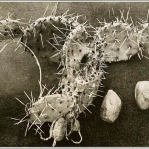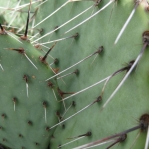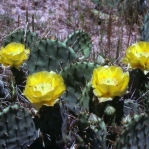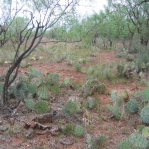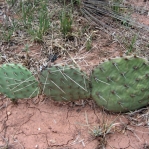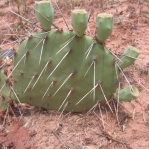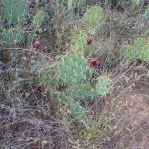
Rose, Contributions from the U.S. National Herbarium 13: 310, 1911
Holotype; Isotype; Isotype; Herbarium; Herbarium; Herbarium; Herbarium; Herbarium (as O. roseana); Herbarium (as O. roseana); Painting; Photograph; Photograph
Original Citation
What is Opuntia mackensenii?
Opuntia mackensenii is a prickly pear cactus found in northern Texas and adjacent areas. Many specimens have tuberous roots. It can be mistaken as a form of O. macrorhiza or even O. phaeacantha.
Details
O. mackensenii is clearly described by Powell and Weedin. O. mackensenii is a prostrate plant to 1 m across. It may have ascending branches. Plants are up to 30 cm tall if branches ascend. Cladodes are subcircular or obovate, 8-16(20) cm in diameter. One to four spines are present in upper areoles. Plants may have pale spines but commonly have spines grading to black at the base. Sometimes spines are distinctly black and white.
Flowers are medium-sized and yellow. Fruit is spineless and oval or sometimes narrower with/without a contracted base, 4-5(6) cm long, truncate at apex, with nearly colorless and pleasant-tasting pulp. The seeds are orbicular or suborbicular, 5-6 mm in diameter, nearly white, and with acute margins.
O. mackensenii is tetraploid.
Other Notes
Powell and Weedin also describe O. mackensenii var. minor.
O. mackensenii is similar to O. phaeacantha, but the latter taxon is hexaploid. Pads are greener and softer looking than those of O. phaeacantha, and the fruit is richer in color (most often redder). It is commonly found over the northern half of Texas and reaches into Kansas, Missouri, Arkansas, New Mexico, and Oklahoma. It is often confused with O. macrorhiza especially because field guides do not have a slot for it.
O. mackensenii was renamed O. Edwards at one point. However, the type specimen was incorrect, and the name fell by the wayside.

